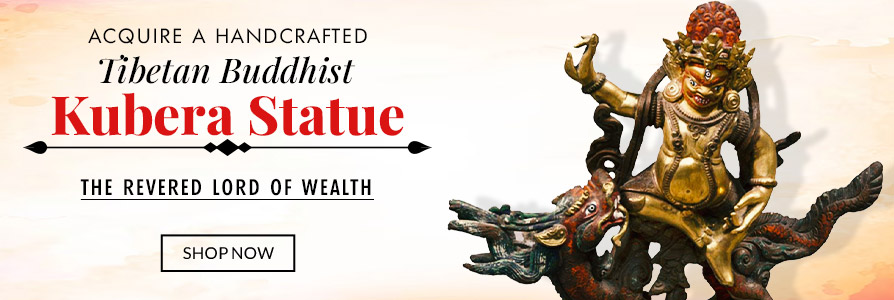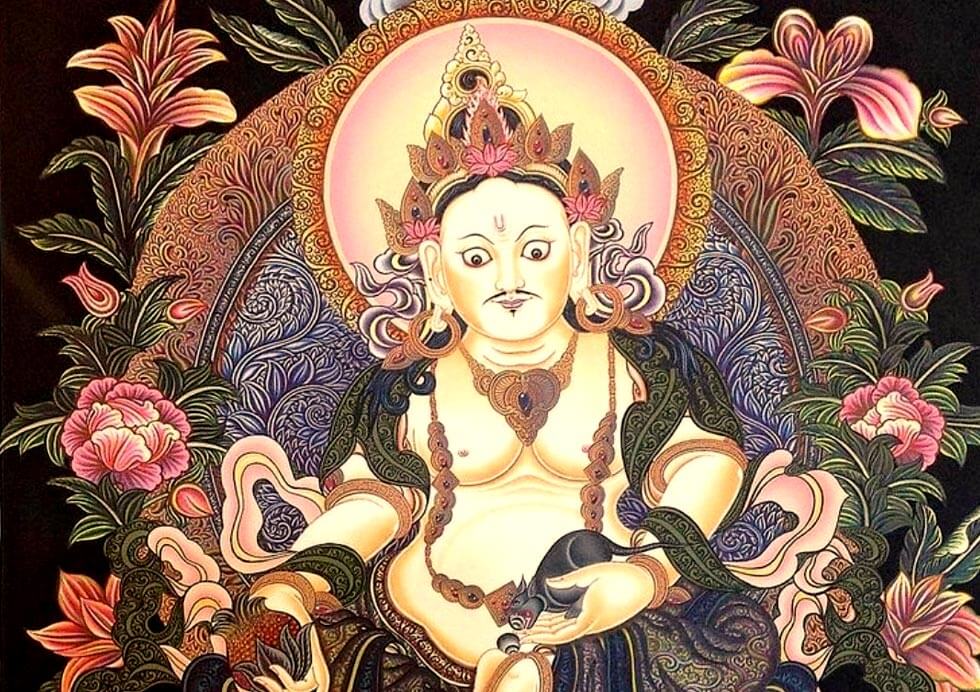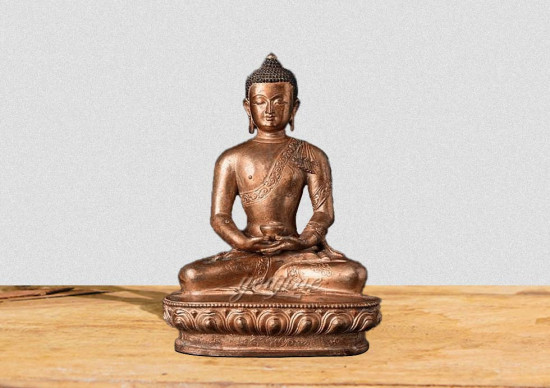
Kubera, also known as Kuvera, is a significant deity in Hinduism, revered as the Lord of Wealth and the King of the Yakshas. Born as the son of Rishi Vishrwa, Kubera is recognized not only for his association with wealth but also for his pivotal role in various Hindu epics.
As the brother of the demon king Ravana, Kubera is often linked to the epic Ramayana. In this narrative, he plays a crucial role in the story of the Lanka conquest by Lord Rama. It is said that Kubera originally ruled over the magnificent city of Lanka, but due to his benevolent nature and devotion to Lord Shiva, he was granted the kingdom of Alakapuri by the divine.
Kubera is frequently depicted as a stout, dwarf-like figure adorned with jewels, symbolizing his immense wealth and opulence. He is often portrayed carrying a mongoose, known as Nakula, which is believed to be a symbol of his prosperity.
In Hindu traditions, Kubera is not only associated with material wealth but also with spiritual prosperity. Devotees seek his blessings for financial success, abundance, and overall well-being. Temples dedicated to Kubera can be found in various parts of India, where rituals and prayers are performed to invoke his favor. The Lord of the Yakshas is also considered the treasurer of the riches of the world and is entrusted with safeguarding the treasures of the earth. Kubera’s abode, Alakapuri, is described as a celestial city of unparalleled beauty and grandeur.
As the brother of the demon king Ravana, Kubera is often linked to the epic Ramayana. In this narrative, he plays a crucial role in the story of the Lanka conquest by Lord Rama. It is said that Kubera originally ruled over the magnificent city of Lanka, but due to his benevolent nature and devotion to Lord Shiva, he was granted the kingdom of Alakapuri by the divine.
Kubera is frequently depicted as a stout, dwarf-like figure adorned with jewels, symbolizing his immense wealth and opulence. He is often portrayed carrying a mongoose, known as Nakula, which is believed to be a symbol of his prosperity.
In Hindu traditions, Kubera is not only associated with material wealth but also with spiritual prosperity. Devotees seek his blessings for financial success, abundance, and overall well-being. Temples dedicated to Kubera can be found in various parts of India, where rituals and prayers are performed to invoke his favor. The Lord of the Yakshas is also considered the treasurer of the riches of the world and is entrusted with safeguarding the treasures of the earth. Kubera’s abode, Alakapuri, is described as a celestial city of unparalleled beauty and grandeur.
Kubera and Wealth
Kubera is intricately associated with various facets of wealth, embodying the essence of opulence in the realms of jewels, natural prosperity, and minerals. As the Lord of Wealth and the ruler of Alakapuri, the celestial city, Kubera holds sway over the abundance of treasures and riches. Jewels, in particular, are under his divine patronage, symbolizing not only material affluence but also the brilliance and allure that accompany prosperity.
In his role as the guardian of nature’s bounty, Kubera oversees the flourishing of landscapes and the fertility of the earth, ensuring a harmonious coexistence with the environment. This association with nature’s prosperity extends beyond mere material wealth, encompassing the flourishing of flora and fauna, the richness of the soil, and the overall abundance that characterizes a thriving ecosystem.
Furthermore, Kubera’s influence extends to the realm of minerals, where he governs the hidden treasures concealed within the earth. From precious metals to rare gemstones, these underground riches fall under his auspices, highlighting his dominion over the subterranean wealth that contributes to the world’s abundance.
In essence, Kubera’s association with wealth transcends a mere accumulation of riches; it encompasses the multifaceted dimensions of prosperity, from the resplendence of jewels to the flourishing of nature and the concealed treasures within the earth. As the divine custodian of wealth, Kubera’s influence permeates various aspects of abundance, embodying the magnificence and affluence that define his celestial realm.
In his role as the guardian of nature’s bounty, Kubera oversees the flourishing of landscapes and the fertility of the earth, ensuring a harmonious coexistence with the environment. This association with nature’s prosperity extends beyond mere material wealth, encompassing the flourishing of flora and fauna, the richness of the soil, and the overall abundance that characterizes a thriving ecosystem.
Furthermore, Kubera’s influence extends to the realm of minerals, where he governs the hidden treasures concealed within the earth. From precious metals to rare gemstones, these underground riches fall under his auspices, highlighting his dominion over the subterranean wealth that contributes to the world’s abundance.
In essence, Kubera’s association with wealth transcends a mere accumulation of riches; it encompasses the multifaceted dimensions of prosperity, from the resplendence of jewels to the flourishing of nature and the concealed treasures within the earth. As the divine custodian of wealth, Kubera’s influence permeates various aspects of abundance, embodying the magnificence and affluence that define his celestial realm.

How did Kubera Become Lord of Yakshas?
The story of how Kubera became the Lord of the Yakshas is rooted in Padma Purana and is often associated with his devotion to Lord Shiva. Kubera, originally named Kuvera, was the son of the sage Vishrwa. Despite being born into a lineage of great wisdom, Kubera had a rather unattractive appearance, which led to him facing ridicule from his stepmother. Frustrated by the constant mockery, Kubera sought penance to attain the favor of Lord Shiva.

Kubera chose the sacred location of Mount Kailash, the abode of Lord Shiva, to undertake his rigorous penance. For many years, he engaged in severe austerities and deep meditation, demonstrating his unwavering devotion to the divine.
Pleased by Kubera’s dedicated penance, Lord Shiva appeared before him. The compassionate deity granted Kubera not only his boon but also a divine kingdom. In recognition of Kubera’s devotion and to reward him for his sincerity, Lord Shiva bestowed upon him the lordship of Alakapuri, the celestial city, and appointed him as the ruler of the Yakshas.
From that moment forward, Kubera became the Lord of Yakshas, entrusted with the responsibility of overseeing their well-being and ensuring the prosperity of his divine kingdom. The Yakshas, celestial beings associated with nature and wealth, acknowledged Kubera as their leader and revered him for his piety.
Kubera’s story is often cited to emphasize the divine rewards bestowed upon those who earnestly seek the favor of the gods through sincere spiritual practices.
Pleased by Kubera’s dedicated penance, Lord Shiva appeared before him. The compassionate deity granted Kubera not only his boon but also a divine kingdom. In recognition of Kubera’s devotion and to reward him for his sincerity, Lord Shiva bestowed upon him the lordship of Alakapuri, the celestial city, and appointed him as the ruler of the Yakshas.
From that moment forward, Kubera became the Lord of Yakshas, entrusted with the responsibility of overseeing their well-being and ensuring the prosperity of his divine kingdom. The Yakshas, celestial beings associated with nature and wealth, acknowledged Kubera as their leader and revered him for his piety.
Kubera’s story is often cited to emphasize the divine rewards bestowed upon those who earnestly seek the favor of the gods through sincere spiritual practices.
Iconography of Kubera
Lord Kubera, often portrayed as a dwarf in Hindu iconography, is characterized by a complexion resembling lotus leaves and a prominent belly. Descriptions of him include three legs, eight teeth, one eye, and embellishments with jewels. Some depictions show him riding a man, while others highlight his accessories, such as a mace, pomegranate, or money bag in hand. Additionally, he may carry a sheaf of jewels or be accompanied by a mongoose, symbolizing his victory over nāgas, the guardians of treasures, particularly emphasized in Tibetan Buddhism.
In the Vishnudharmottara Purana, Kubera is symbolized as both the embodiment of Artha (wealth, prosperity, glory) and the Arthashastra treatises. Described with a lotus leaf complexion, he rides a personification of the state, adorned in golden attire, representing his wealth. Kubera’s yellow left eye, armor, and necklace down to his substantial belly contribute to his distinctive features.
The Purana also details his face’s left inclination, adorned with a beard and mustache, and two small tusks signifying his ability to both punish and bestow favors. His consort, Riddhi, representing life’s journey, sits on his left lap, holding a jewel-pot. Kubera, depicted as four-armed, wields a mace (symbolizing administration of justice) and a shakti (power), with accompanying standards bearing a lion (symbolizing Artha) and a shibika (club, Kubera’s weapon). Nidhi treasures Padma and Shankha, in human form, standing beside him with their heads emerging from a lotus and a conch, respectively.
According to the Agni Purana, Kubera should be installed in temples seated on a goat, holding a club. The prescribed image of Kubera is often of gold, adorned with multi-colored attributes. In some sources, particularly Jain depictions, Kubera is portrayed as a drunkard, evident through the presence of a “nectar vessel” in his hand.
In the Vishnudharmottara Purana, Kubera is symbolized as both the embodiment of Artha (wealth, prosperity, glory) and the Arthashastra treatises. Described with a lotus leaf complexion, he rides a personification of the state, adorned in golden attire, representing his wealth. Kubera’s yellow left eye, armor, and necklace down to his substantial belly contribute to his distinctive features.
The Purana also details his face’s left inclination, adorned with a beard and mustache, and two small tusks signifying his ability to both punish and bestow favors. His consort, Riddhi, representing life’s journey, sits on his left lap, holding a jewel-pot. Kubera, depicted as four-armed, wields a mace (symbolizing administration of justice) and a shakti (power), with accompanying standards bearing a lion (symbolizing Artha) and a shibika (club, Kubera’s weapon). Nidhi treasures Padma and Shankha, in human form, standing beside him with their heads emerging from a lotus and a conch, respectively.
According to the Agni Purana, Kubera should be installed in temples seated on a goat, holding a club. The prescribed image of Kubera is often of gold, adorned with multi-colored attributes. In some sources, particularly Jain depictions, Kubera is portrayed as a drunkard, evident through the presence of a “nectar vessel” in his hand.

In summary, Lord Kubera stands as a prominent figure in Hinduism, revered as the Lord of Wealth and the King of the Yakshas. His story, rooted in devotion and divine blessings, highlights the multifaceted dimensions of prosperity, from material riches to the flourishing of nature and the hidden treasures within the earth. Kubera’s role as the guardian of wealth extends beyond a mere accumulation of riches, embodying the magnificence and affluence that define his celestial realm. His iconic representation, often portrayed as a dwarf adorned with jewels, carries profound symbolism, emphasizing his divine influence over various aspects of abundance. Temples dedicated to Kubera serve as places of worship where devotees seek blessings for financial success, abundance, and overall well-being. As the Lord of the Yakshas, Kubera’s story continues to resonate, underscoring the divine rewards bestowed upon those who earnestly seek spiritual connection and practice sincere devotion.









